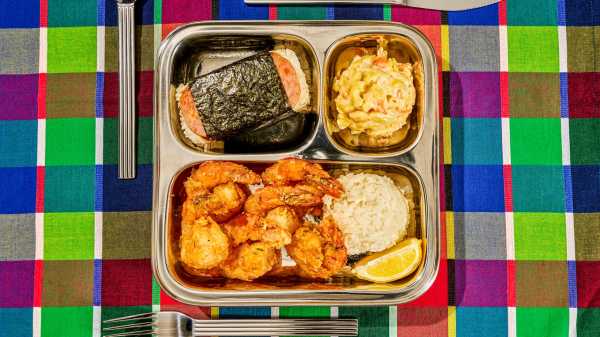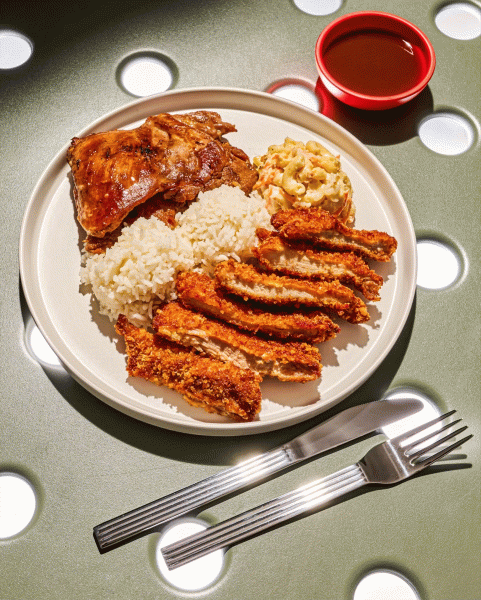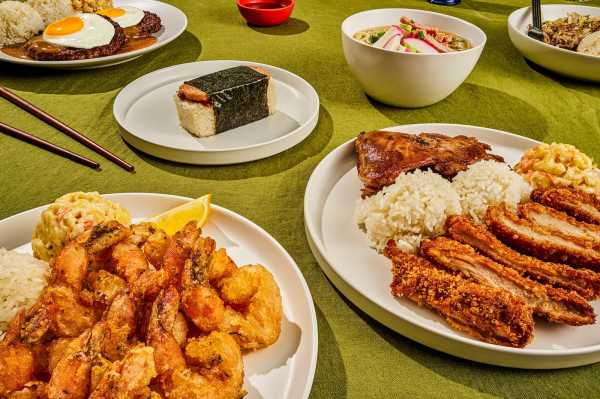
Save this storySave this storySave this storySave this storyYou’re reading the Food Scene newsletter, Helen Rosner’s guide to what, where, and how to eat. Sign up to receive it in your in-box.
There’s something almost ritualistically precise about the Hawaiian plate lunch. A scoop of pale macaroni salad, almost quietly radical in its steadfast, defiant plainness, nestles next to two scoops of white rice (it must be two, never three, never one). The rice serves as both a foundation and a mediator, bridging the creamy blandness of the pasta salad with the blunt-instrument intensity of the plate lunch’s third and central component, one kind or another of salty, savory meat.
Alongside poke bowls and the sport of surfing, the plate lunch has become one of the hallmarks of the fiftieth state. To understand the dish is to understand Hawaii’s particular genius for cultural synthesis. Its origins lie in the colonial plantations of the late nineteenth century, when agricultural workers—Indigenous Hawaiians, in addition to people brought in from Japan, China, the Philippines, and elsewhere—laboring on the islands’ vast fruit and sugar fields broke at midday for easy, cheap meals of rice packed up with whatever leftovers and accoutrements were handy. As Hawaii’s economy shifted throughout the years, so did lunch: ersatz food carts and wagons sprang up, serving meals similar to what workers would have brought from home: Japanese katsu, Chinese char siu, Filipino adobo; rice, of course, and macaroni salad, mild and mayonnaise-y, the indelible influence of the American mainland. The carts, in time, were supplemented with proper restaurants and, inevitably, chains both small and large. Today, you can find plate lunch served from trucks parked near construction sites and surf spots, from counters in strip malls, and from trendy, photogenic up-and-comers that gild the lily with carefully sourced ingredients and thoughtful little flourishes. The soul of the plate lunch remains unchanged: it is, fundamentally, a working person’s lunch, caloric and rib-sticking, elevated, through the decades, to something approximating an icon.

In addition to variations on plate lunch, the menu includes a Hawaiian take on ramen.
L&L Hawaiian Barbecue, as its known today, began in Honolulu in 1976. It now has more than two hundred outposts worldwide and is probably the largest plate-lunch operation going. After blanketing Hawaii’s islands with some forty-nine shops by 1999, the company’s founder, Eddie Flores, Jr., and his business partner turned their sights to the mainland, débuting an L&L in a shopping-mall food court in Industry, California. New York got an L&L in 2004 and lost it again about a decade later; in the years since, a hungry person in this town wanting plate-lunch flavors had few options. I mostly sated my cravings on the other end of an airplane, with breakfast at Rutt’s Hawaiian Cafe, in L.A., or with the heavenly loco moco at a coffee shop attached to a bowling alley in Gardena, California. Here at home, one of the most notable of the city’s Hawaiian restaurants is Noreetuh, a hip, cheffy spot where, sure, you can get Spam musubi, a handheld snack of rice and meat painted with teriyaki sauce, all wrapped up in a sheet of nori. But it’s on the menu next to a thirty-eight-dollar version made with Hokkaido uni, to which a dollop of osetra caviar can be added for thirty-five bucks more. Noreetuh is a smart, ambitious restaurant, but I can’t pretend it scratches the plate-lunch itch: when you think about the platonic ideal of Hawaiian mac salad, it’s not coming from a menu with the affectedly austere description “raw onions, carrots, dairy.”

L&L’s imprint in New York includes two outposts in Manhattan and a forthcoming one in Bushwick, Brooklyn.
At last, L&L is back, now run by the franchisees Henry and Sephra Engel, siblings from Oahu. A nice little storefront on Allen Street, just below Houston, opened last fall; another location popped up in East Harlem a few weeks ago, and a Bushwick one promises to open soon. They don’t offer a slick, sleek, Instagrammy experience; L&L is a mid-tier fast-food chain and looks every inch of it. The space is efficient and to the point, with TV-screen menus above the ordering counter (which bears the word “ALOHA” in large letters) and a self-serve drink refrigerator containing Hawaiian Sun juices and punches. Framed posters, charmingly unhip in a central-office-issue sort of way, advertise specialties and delights: “Classic Combos,” “Hawaii’s Favorites,” “Cater with Us.” A potted plant near the glass front wall, green fronds waving gently in the breeze from the HVAC, nods to the tropical paradise at which, by means of rice and sauces, the plate lunch obliquely gestures. As on most fast-food menus, what appear to be a vast number of options are actually just a few core elements, remixed this way and that: teriyaki-marinated chicken thighs; kalua pork, pulled with just a hint of smoke; salty-sweet beef ribs cut kalbi-style, crosswise against the bones; big, meaty shrimp tossed in a slippery, gorgeously garlicky sauce. You’re here for the plate lunch, but you could also get a “bowl”—smaller, no mac—or, I guess, a cheeseburger, though that seems a little bit perverse.
Helen, Help Me!
E-mail your questions about dining, eating, and anything food-related, and Helen may respond in a future newsletter.
L&L’s food hits with all the subtlety of a sledgehammer, and that’s exactly the point. There are leavening notes here and there: a jazzy sliver of cruciferousness from the cabbage that comes with the kalua pork, or the sharp whistle of vinegar that runs through the thin, sweet sauce drizzled over the juicy, panko-crisped chicken katsu (my clear favorite of the proteins). When making your selection, skip the loco moco, made with plain hamburger patties doused in flavorless brown gravy and topped with two fried eggs. You can also pass on the saimin, the restaurant’s take on Hawaiian ramen—made with a dashi broth and whatever meaty toppings your heart might desire—which is so salty as to be near-inedible. Get a musubi or two, which is marvellous, the squishy pillow of rice, the ineffable Spamminess of Spam, the sweet smear of teriyaki. With the exception of the loco moco, the plate lunch doesn’t miss—even the macaroni salad, in its soothing simplicity, is exactly right—it’s a big, brawny meal to fuel a hard day’s work, or a long afternoon’s nap. These meals, which are good and filling, are unconcerned with the fickle tides of novelty or the performance of theme dining. The portions are enormous, the prices reasonable, the flavors straightforward: salt, fat, acid, meat. ♦
Sourse: newyorker.com







